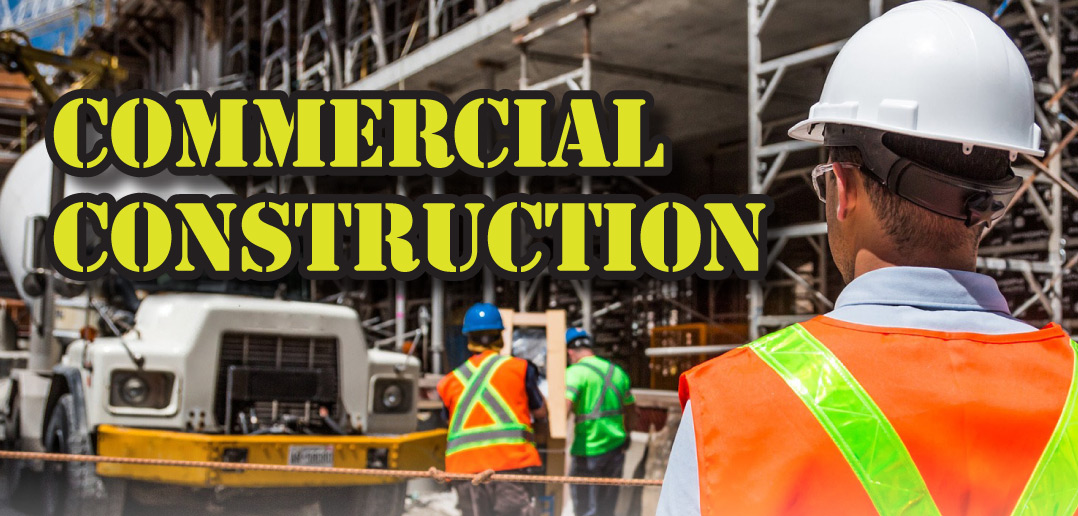Commercial Construction in Omaha, NE 2018
Just about anywhere you go within the Omaha metropolitan area the growth of the commercial landscape is evident. This holds true for development in Omaha and surrounding suburban cities as well as nearby small towns that are experiencing unprecedented growth of their business districts and municipal areas, or similarly, urban revitalization efforts.
All around the Omaha Metro, you’ll see signage in front of the major projects with the familiar, most prominent names in the industry here locally, all of which are currently hard at work at prominent construction sites.
As we enter the time of year when construction projects literally “spring up” everywhere, it’s exciting to see the transformation happen through summer and fall. (As opposed to the dreaded road construction everywhere, for which “exciting” would not be the term used by most, although it is a necessary evil.) Furthermore, in addition to breaking ground on new and exciting projects, and the many others in the various stages up until completion that are visible to passersby, there are plenty in the planning stages too.
{The Project}
Here in the Omaha Metro, we’re fortunate to have some of the best in the business when it comes to experienced, highly-skilled industry professionals. That being the case, when selecting the right one(s) for the job, it’s more about what you want to accomplish and how you want to go about it.
There are several project delivery methods – design/bid/build, design/build, and construction management. In the traditional design/bid/build method, the owner contracts with separate entities for the design and construction of the project. The owner first engages an architect and gets the plans put together. If an architect has been brought on board for a project, it’s a good sign to the other professionals that it’s going to move forward, so it does generate interest from contractors. The project is then put out for bid, which can be to a public (open) or private (select) audience of contractors. Generally, if it’s public, the lowest bidder with a responsible proposal will be selected. If it’s private, that’s not always the case. Once the build phase has been awarded to the contractor, the construction process begins. The general contractor generally limits their role to managing the construction process and daily activity at the construction site, while subcontractors will be used for supplying materials and installation.
With design/build, the owner hires a general contractor, and that company hires the professionals for design or does the design work in-house and is responsible for performing all of the work that’s called for in the plans.
Finally, in the construction management role, the general contractor works as an agent of the owner and an advocate on their behalf. They are there to oversee everything, and through active involvement and offering recommendations, ensure the owner gets the best value.
Although the fundamentals remain largely the same among firms across the industry, there is a certain degree of variance that lies in the smaller details, with aspects and approaches that make each unique.
“There are a lot of great contractors in the area,” notes Justin Kurtzer with Cheever Construction. “What we feel really sets us apart is we are an employee-owned firm. When someone shows up on the job site there’s a personal investment as well as involvement on a professional level. You’ll find that to be the same no matter who you work with at Cheever. Our clients understand that and appreciate that; there’s a mutual trust and respect between us that establishes a solid foundation from the start that extends throughout the project.
As a commercial general contractor, Cheever Construction provides complete coordination of obtaining competitive bids from all trade subcontractors, administering contracts and supervising all phases of construction.
Cheever Construction has a proven track record as the builder on many types of commercial projects: schools, churches, office buildings, medical facilities, manufacturing, and senior living. We routinely complete smaller-scale projects and large multi-million projects alike.
Recently our involvement by project type has been skewed towards medical facilities, and we’re seeing a lot of interest in senior housing too. For both, the demand is predominantly being driven by baby boomers. These are trends nationwide and Nebraska continues to have prime opportunities for development in those areas as well as in other key market segments.
Educational institutions are another big one. There has been a significant push recently with the addition and enhancement of K-12 schools and facilities. Development of university and community college campuses is also ongoing, with many improvements being made and new facilities being added.
If you’re considering doing any type of commercial construction project, my advice would be don’t rush it. It’s an involved process, so it does take time, and longer than one might think, to get quality results. Ask for references, review past examples of work, and talk to others who have undertaken similar projects. Finally, let the professionals help guide you through the process and keep your expectations high but reasonable at the same time.”
While there is a lot of development on the outskirts of the city as it expands and new areas are being zoned for commercial or residential use, there’s also plenty going on centrally and spread throughout the business districts and historic neighborhoods of the Omaha Metro area. You’ll find this to be true in Aksarben Village, Benson, Old Market, Dundee, La Vista, Papillion, Ralston, Bellevue, and so on. Here, since it’s not commonly open land unless a building is razed to make way for something new, there are generally two options, with the other being repurposing the existing structure.
“We’ve seen a large push to rehabilitate buildings and structures versus demolishing them and rebuilding,” says Matt Buol-Ferg with McGill Restoration. “This decision is usually driven by cost, and there are many new technologies, products, and applications that allow for the rehabilitation of these structures and maintain or even improve their performance.
As previously mentioned by another professional, be prepared to spend time on educating yourself on the new technologies that are being developed. Vendors and manufacturers are usually more than happy to come in and talk to you about the ‘new toy’ that they have to offer. Understanding what that is and how you can use it to benefit your projects is important and will keep you competitive. At McGill Restoration, we are always looking into new and innovative solutions to improve our offerings. New products and new ways of performing jobs are constantly being developed. Staying on top of those new innovations keeps us more aware of what’s going on the industry as well as keeping us competitive.”
As there are many different professionals involved in a single commercial construction project, Buol-Ferg also notes, “Having the technical knowledge and experience to look at a set of drawings and specs and understand what the architect and/or engineer is trying to accomplish is invaluable. So is good communication and attention to detail. In my role as Lead Estimator, having the ability to quickly transition from project to project, and compartmentalize the information from each, depending on the needs at that moment of the team is extremely important. I may look at 5 or 6 projects throughout the day, and if I can’t keep the information from each one separate it will cause problems.”
{The Integration}
Being detail-oriented is a core trait that is shared by professionals across all fields involved in the various stages of construction projects. From planning to execution, there is a lot to take into account in order to deliver an end result that best serves the client.
Aesthetics and functionality are equally important elements of a commercial space, and accordingly, should be cohesive. Today, with technology integration becoming commonplace, and offering a world of possibilities, it will surely be a part of the equation on both accounts.
“Commercial construction projects seem to be focusing on the aesthetics and functionality of boardrooms, meeting rooms and collaboration spaces more than ever before,” says Jason Muehlhausen with Echo Systems. “To that end, room scheduling is a trend on the rise. Room scheduling integrates with popular calendaring programs you’re already using to improve workflow and room usage.
Also, direct view LED video wall technology is becoming an increasingly popular video wall solution due to its ability to deliver seamless images, scalability to any size or shape, and excellent optical characteristics. The new LED video walls span from 0.9 to 20-millimeter pitches.
Echo Systems specializes in design-build A/V subcontracting, A/V system design, engineering, installation, programming, consulting, video conferencing, A/V control systems, lighting control, motorized shade solutions and video surveillance. We mainly perform work for clients who are building and improving their corporate, financial, higher education, healthcare, and house of worship institutions.
As a design-build A/V subcontractor, we usually recommend the addition of a fully-integrated A/V control system during a new construction project for commercial use, specifically for the areas I previously mentioned. Specific A/V control systems allow clients to monitor A/V equipment over their network. Another recommendation is integrated lighting control and motorized shades to conserve energy costs, which can benefit any commercial-use space.”
As one might expect, advancements in technology that apply to commercial construction projects are abundant and ever-evolving. Technology has indeed revolutionized many aspects of how commercial-use projects are built as well as what is being built for the end-user and its functions once completed and in use.
We’ve already covered A/V integration, but building management systems are another great example.
“Building management systems (BMS) provide efficient control of internal comfort conditions, effective use of energy, and quick and effective responses to HVAC and security problems that save both time and money,” Pat Killeen with Engineered Controls articulates. “The BMS systems also provide information on problems in the building, allow for computerized maintenance scheduling, are easy and effective for employees to use, and easily detect problems.
There is now considerable interest in energy-efficient buildings, high-tech devices and enhanced security systems that are now central components of building management systems. For example, lighting control systems with dimming and light-harvesting capabilities are generating an especially high demand.
By integrating HVAC, lighting and security functions all within one common BMS platform, a building’s power systems–lighting and illumination; electric power and control; security, video surveillance and magnetic card access; heating, ventilation and air-conditioning systems–will all be monitored and controlled from one central location.
Although hardwired building management systems have been around since the late 70s, wireless technology has revolutionized the building automation system market.
Long-range analysis shows that there are a number of business sectors that are currently and will continue to drive the BMS sector of the building technology industry in the future. These include the demand for ‘green building technology,’ electrical energy management systems, LED lighting and lighting controls, security and access systems, asset management, smart buildings and the technology convergence into one holistic Building Management System.”
For those taking on projects in the future, he advises, “I would tell clients interested in adding building control technology to their new building to do their research. There is plenty of information on the internet today that will make the average building owner much more knowledgeable about what is available in the commercial construction market than anyone realizes.
Next, I would suggest that building owners need to get to know the consulting engineers that are designing their buildings. It is crucial that building owners are smart consumers and participate in the design process. Since the new construction industry consists of architects, consulting engineers, general contractors, mechanical contractors, and so on, many of the basic decisions that are being made regarding system type, configuration, manufacturer, functionality, etc. are all being made by everyone EXCEPT the customer.
Far too often we see building owners moving into a new building only to find out that they did not get what they wanted. Or occasionally the BMS system is too complicated for them to operate. The moral of the story is to get involved, ask questions, know what you want, and know what you are getting BEFORE the decisions are made by everyone but you, the customer.”
{The Contract}
Along the same lines, the formal agreement you enter with the professionals you’re hiring for your project should cover all aspects of the project scrupulously.
Emphasizing the importance of clear language in a construction contract, Goosmann Law Firm offers the following advice:
“Construction and contracts operate in the same way – multiple parts coming together to form one cohesive item.
Construction projects require specifications for measurements, elements of building products, and the amount of materials to be used. Contracts are put together as a document that addresses the intentions of the parties involved. Construction contracts are based on the premise that someone wants something built or fixed, and someone else agrees to build or fix something. If only the drafting of construction contracts could be that simple.
Construction contracts set out the responsibilities, obligations and duties of the parties involved. The parties generally intend to follow those responsibilities, obligations, and duties. The intentions of the parties, however, are not always set out in clear, unambiguous terms. Ambiguity can arise when a term or phrase in a contract can be reasonably interpreted to have more than one meaning. To minimize the possibility of ambiguity in a construction contract, consider the following tips:
- Use plain language, with straightforward terms and clauses. A contract that becomes bogged down in technical terms or run-on clauses will open the door for claims of ambiguity. Clear, succinct, and easy-to-understand phrasing helps the parties express their intentions without too much ‘legalese.’
- Take punctuation seriously. A misplaced or omitted comma could mean dire consequences. In early 2017, the United States First Circuit Court of Appeals sided with delivery drivers who argued four years of overtime pay was due because an Oxford comma was missing in their contract language. If you want to know how the case turned out, Google ‘10 million-dollar Oxford comma.’
- If a technical term or industry-specific term is used, add the definition of the term to the contract. If the term becomes an issue for litigation or arbitration, the outcome will be determined on how the parties intended the term to be used at the time the contract was executed. A clear definition in the contract of terms will help alleviate questions of ambiguity that could be raised.
Careful contract drafting is a valuable way to avoid disputes. If you find a construction contract too wordy, or too vague, read it out loud. Make sure you understand what you are reading, and that it matches your intentions for agreeing to the contract.
For additional information regarding construction law and contracts, contact our Omaha law firm today at (402) 280-7648 or visit our website at www.GoosmannLaw.com.”
{The Space}
Finally, beyond the construction of the building, establishing the infrastructure, and installation of the main systems, there are many other details that will go into finishing a commercial space.
Once those items are complete, it then will undergo a transformation on the inside to become your office, shop, boutique, salon, restaurant, showroom, etc. Having the opportunity to make the space your own, for many, is the most exciting part of the process. From the flooring and paint to cabinets and finishes to furniture and décor, the potential here is limitless. Working with a professional interior designer is advised, as well as the design team at any of the vendors you’ll use for the different features.
When making decisions with these professionals, it’s easy to focus on the price tags associated with the options, but don’t lose sight of the fact that the quality of materials is imperative. Durability and longevity are key to getting the most out of your investment. Using tile as an example, larger tiles in a quality porcelain material have gained popularity because of their attractiveness and durability, and larger floor mat tiles, plank tiling, faux wood, and other scratch-resistant finishes remain on trend for the same reasons. It’s worth paying an extra dollar or two per square foot for a finished product that will look much better as well as having a longer life before replacement is needed. A professional will be able to guide you as to the pros and cons of the various materials you’re thinking about incorporating to ensure you’re making an educated decision. For anything that has to do with tile design and installation, Modern Concepts Tile will deliver a functional yet at the same time attractive, unique, and impressive end product. Again, you get what you pay for, and the appearance of your place of business, inside and out, and the environment you’re able to create is part of your brand signature and an extension of your reputation. The impression it makes on your customers and those who are considering doing business with you in the future, and the effect it has on your employees, is not to be underestimated.
{The Tools}
Attention contractors: Have you ever been working on a project and discovered you needed a certain tool or piece of equipment that you didn’t have readily available? Chances are it’s not something you use on a regular basis, which means investing in purchasing it might not be the best option. Instead, consider renting it to get the job done!
Meeting that exact need for Omaha-area contractors, Honeyman Rent-All can provide almost any type of tool or piece of equipment that would be used for a commercial construction project. Troy Honeyman with Honeyman Rent-All advises, “Many times on the job, you might need something that you don’t own or have on-hand. That is where we can be of assistance, as we have a wealth of equipment and tools that are available for rental and our staff is here six days a week to help you find exactly what you need to complete the job successfully. We provide hands-on service and if you’re not fully sure how to operate the equipment, we’ll make sure you get a basic tutorial and leave feeling confident about it. At Honeyman Rent-All we take pride in our extensive rental inventory, which includes a wide variety of equipment for specialized projects such as demolition, concrete, drills and attachments, drywall and wallpaper, electric hand tools, floor and carpet, landscaping, generators and welders, hoists, jacks, ladders, lifts, lighting and electrical, measuring and locating, painting, plumbing, pumps and hoses, saws, tractors and trailers, trenchers and skid steers, climate control, cutters, and air equipment. We look forward to working with you to ensure that you have the right equipment and tools for the job, so that you can complete it on time and deliver a quality finished product!”





